Listen to the audio version of this article. Duration: 6 minutes.
The sentinels of daily life serve as time-markers, offering formal solutions that strike a balance between rigour and eccentricity. Through design, some have managed to suspend the flow of time and leave an indelible mark upon it.
German designer Richard Sapper once remarked that “time is one of the few things that can define the quality of an object.” Paraphrasing this, we might say that clocks are truly timeless. In more extreme terms, however, we could argue that some clocks have not merely measured time but have marked it. This doesn’t just mean their ability to translate the passage of time into minutes and hours, functioning as the metronome of daily life, but their power to stop time. They achieve this through the deep connection we form with them, rendering them immune to obsolescence.
Design has played a key role in the reimagining of these objects, often going beyond the simple use of numbers and hands to embrace bold, sometimes ironic, formal solutions that contrast with the meticulous precision clocks typically represent. Below, we present some examples of timepieces that have succeeded in this endeavour more than most.
1.Sunburst Clock/Wall Clock Collection
George Nelson for Vitra
Starting in 1947, American designer George Nelson has created a collection of wall clocks for Vitra that introduced a completely new style. These clocks all share one defining feature: the absence of numbers, while displaying a wide variety of shapes, colours, and materials. The lack of numbers stems from Nelson’s observation that people read the time intuitively, by the position of the hands on the dial. He also believed that, with most people wearing wristwatches, wall clocks had evolved to serve primarily as decorative pieces of furniture.
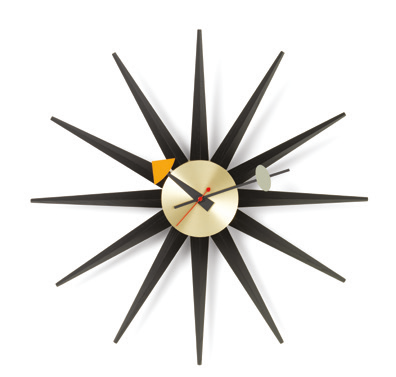
2.Static
Richard Sapper, Lorenz
Designed in 1959 by a young Richard Sapper, Static was commissioned by Tullio Bolletta, the master watchmaker and founder of Lorenz. The aim was to repurpose a stock of mechanical movements acquired as war surplus while simultaneously creating a unique, timeless object. Sapper conceived a cylindrical metal casing that, due to a flat cut on its base, always returns to the same position when rotated—hence the name Static. For the dial’s numbers, Sapper drew inspiration from the instruments of a military aircraft he found at a flea market in Milan. In 1960, the watch won the prestigious Compasso d’Oro award.
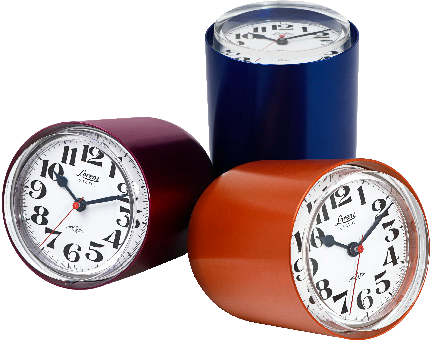
3.Cifra 3
Gino Valli, Solari
Designed by Italian architect and designer Gino Valle in the late 1960s for Solari, the Cifra 3 table clock is recognised worldwide as an iconic design of the 20th century. It is part of the permanent collections at MoMA in New York and the Design Museum in London. The product’s strong communicative personality is key to its design success, achieving a perfect balance of form, size, readability, and the relationship between characters and colour.
Cifra 3 is the smallest direct-reading clock to use the horizontal vane roller system, patented in 1966. Its cylindrical shell houses the number rollers and battery-operated motor.
The gentle movement of the flaps introduces a distinctive, unconventional new sound into the home environment.
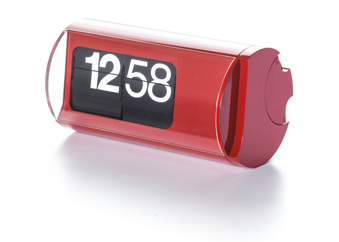
4.Binario
Guzzini
Guzzini’s Binario (Italian for track ), designed by the Guzzini Lab team, is a striking wall clock crafted from opalescent glass. The bold contrast between the black numbers and the bright red, stylised hands defines its distinctive aesthetic. The clock measures 38x4.5 cm.
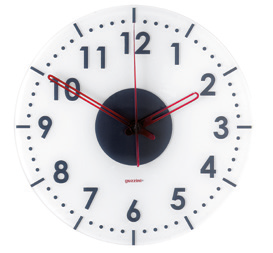
5. Blank wall clock
Martí Guixé, Alessi
The Blank Wall Clock by Alessi is a minimalist wall clock featuring large arrow-shaped hands and no numbers. Spanish designer Martí Guixé believes that objects not only serve a function but also communicate. With this in mind, the clock’s dial is left blank, offering users a white canvas on which they can write, draw, and erase endlessly using the erasable marker clipped on the back of the dial. This allows the aesthetics and message of the clock to be constantly renewed. The clock measures 40x5 cm.

6. Tic&Tac
Philippe Starck with Eugeni Quitllet, Kartell
Designed by celebrity architect Philippe Starck and Eugeni Quitllet, it is Kartell’s first wall clock model. It features a see-through square box with Roman numerals engraved on the surface, framing a flat dial. A pair of slim, coloured hands stand out, creating a mesmerizing contrast that transforms the perception of time into an aesthetic experience. The clock’s substantial thicknesses produce light and reflection effects, enhancing its visual appeal. The case is crafted from ABS, available in solid or metallic colours. The clock measures 30x8 cm.
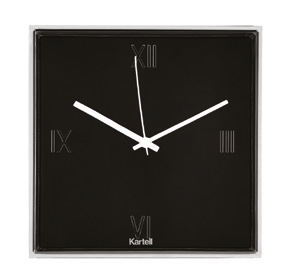
7.Tempo
Naoto Fukasawa, Magis
The wall clock designed by Naoto Fukasawa for Magis is crafted from ABS and follows a minimalist aesthetic. The dial’s markings are kept to the bare essentials, while the hour notches are deliberately thickened, creating a playful effect that evokes pop art influences. The clock measures 30x4 cm.
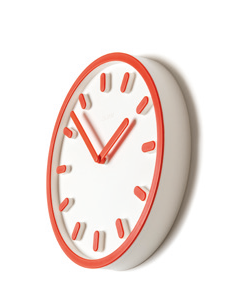
8. Rnd_time
Progetti
The ‘rnd’ in the clock’s name stands for random . The peculiarity of this wall object is given by the fact that the cubes that compose it can be fixed freely to the wall, in a completely random way. The 13 3x3cm cubes - 12 numbered and one for the hands - are in polyamide in wenge colour, while the numbers are in silver.
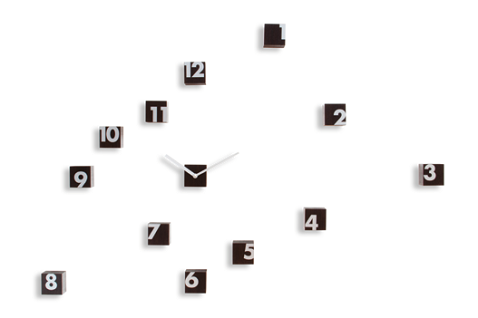
Copyright © Homa 2025
All rights reserved

.jpg?VGhlIFBlcmZlY3QgU2xvdC1pbijmraPnoa4pLmpwZw==)

































